aging
The Grandmas and Grandpas Brewing Beer in Vienna
In the maze of neon-lit corridors beneath a senior home on the southwestern outskirts of Vienna, the warm scent of malt leads to a small room that’s become the headquarters of an unlikely microbrewing success story. A colorful mural on the wall depicts five residents of the home enjoying a pint, and beneath, three of them are pitching in on today’s brewing efforts.
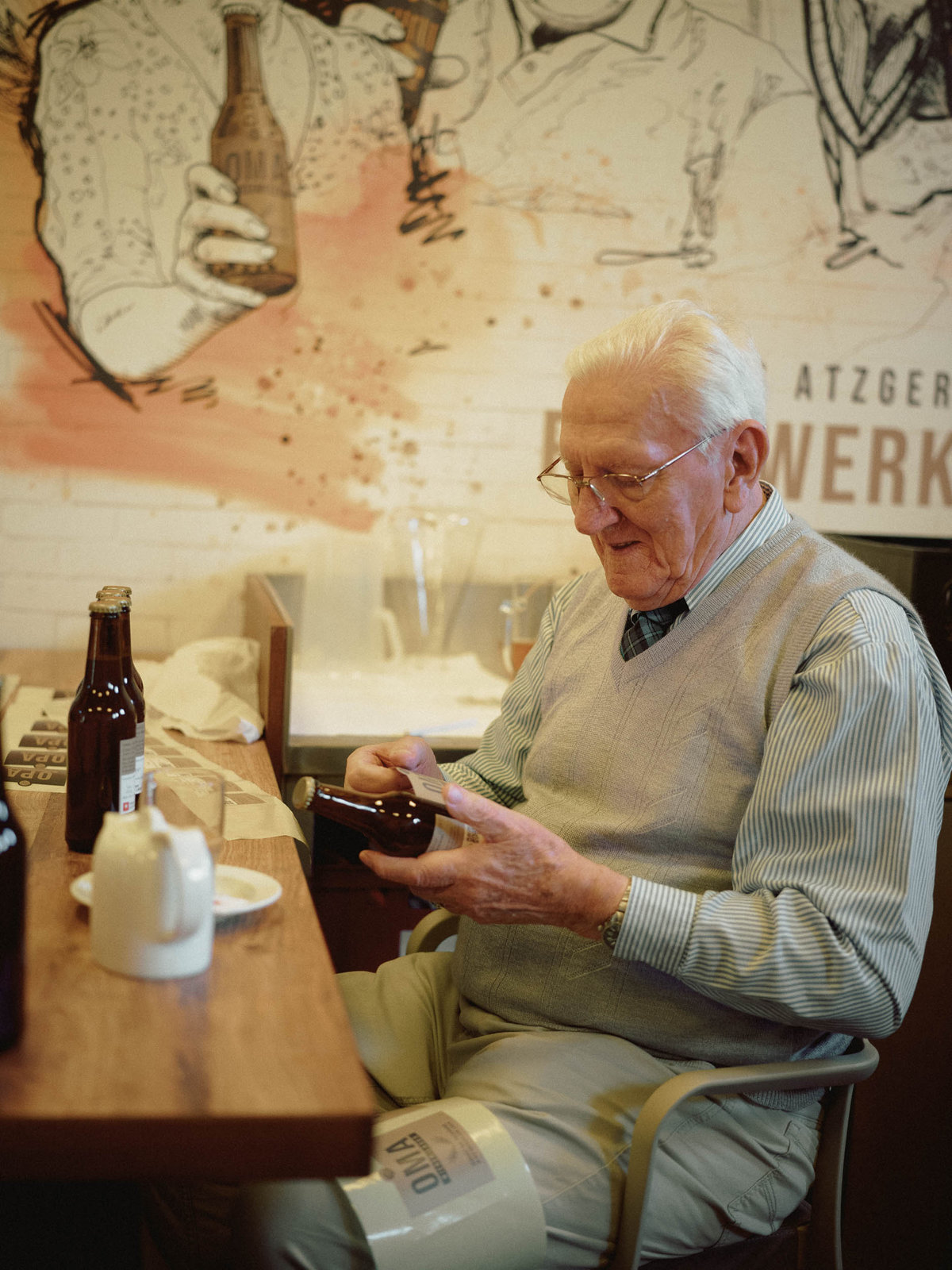 Gustav Paier labeling bottles. Credit: Andreas Jakwerth / Häuser zum Leben
Gustav Paier labeling bottles. Credit: Andreas Jakwerth / Häuser zum Leben
Helmut Riegerbauer always comes in early, and by the time the others have joined he’s already pulled on purple latex gloves and moved to the manual bottle capper. “He’s the only one who gets to wear an official apron,” quips Gustav Paier, himself neatly dressed in a colorful cable-knit sweater. “You have to earn it,” winks Helmut, smoothing the dark green apron emblazoned with the word Brauwerkstatt.
And earn it he does — in the course of the morning he caps around six cases of freshly filled beer bottles, careful to add a tab of priming sugar to each. Occasionally he comes to check on his friends, who are busy with labeling. “I’m the controller,” he explains, swiftly scanning a case and pulling out a bottle missing the back label. Rupert Jaksch, who has taken up his usual position at the end of the table, quickly puts on the missing label for their Viennese lager, called Opa and Oma — Grandpa and Grandma.
The lager was the first beer the Brauwerkstatt in Haus Atzgersdorf started brewing in the summer of 2020, when the Covid lockdowns made life in the senior home especially lonely. The home’s previous director came up with this unusual plan to bring the residents together and give them a meaningful way to spend their time. Helmut, Gustav and Rupert have been part of the project from the start and have become fast friends. They’re all firmly in their 80s, with Rupert the oldest at 88, but the laughter and easy banter make the atmosphere in the room feel unusually festive for a Thursday morning.
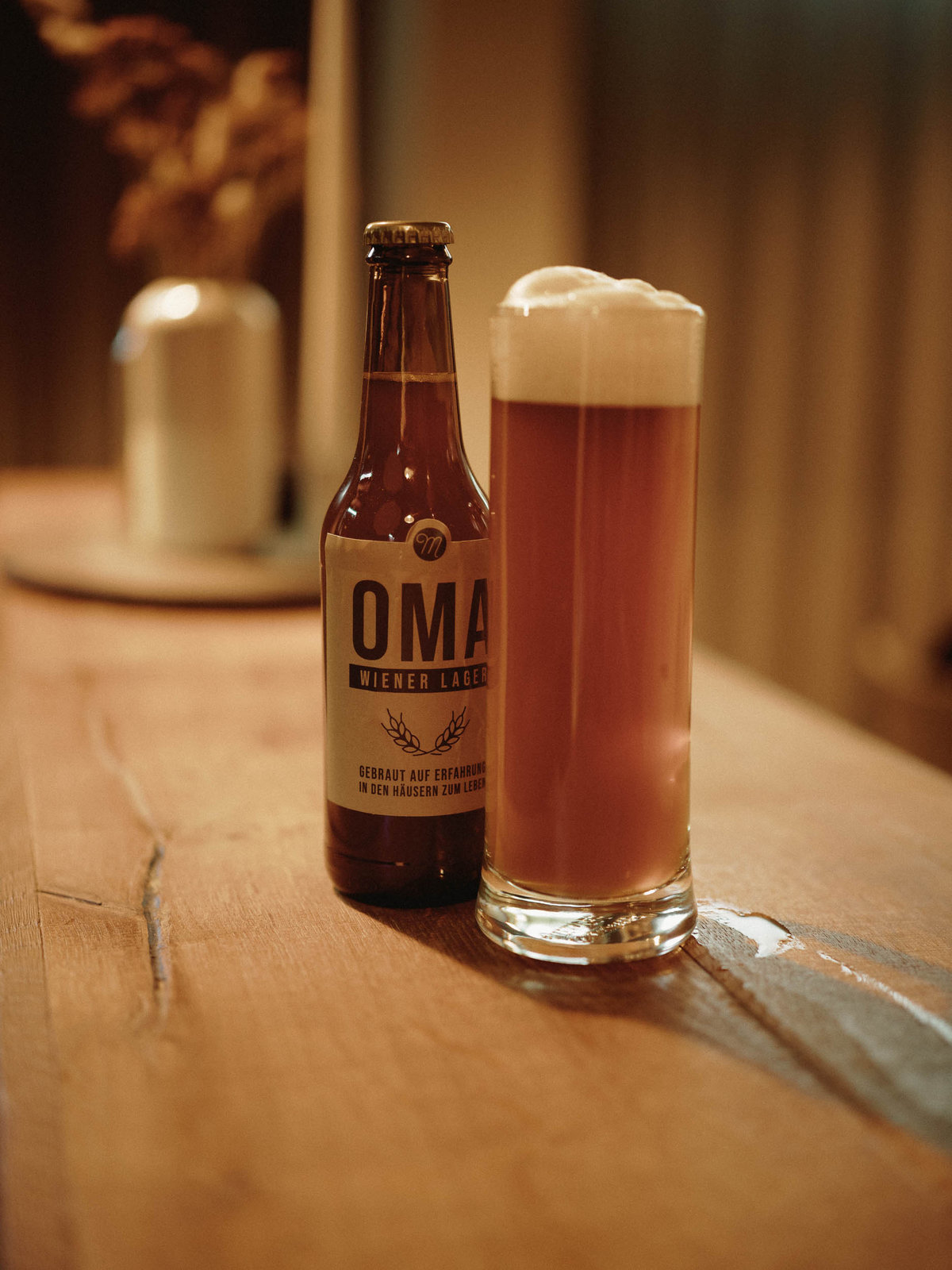 A bottle of Oma (“grandma”) Viennese lager. Credit: Andreas Jakwerth / Häuser zum Leben
A bottle of Oma (“grandma”) Viennese lager. Credit: Andreas Jakwerth / Häuser zum Leben
What started as an off-the-cuff idea has since become a successful microbrewery that can barely keep up with demand. In 2023 the Brauwerkstatt doubled its brewing capacity to 12,000 bottles annually and is planning to double it again this year. The senior home staff takes care of the more physically demanding aspects of the work, but Bernhard Wittholm, a trained beer sommelier who joined the team last year, recognizes that the heart of the project lies elsewhere: “It’s not really about brewing beer but about companionship. The residents have a lot of stories to tell, and it’s good for them to get out of their bubble. You notice that they blossom when they’re here.”
Including the senior residents in the project was crucial from the start, says the home’s director, Christian Ehm: “They’re involved in the whole production process, from brewing to bottling, packaging, a bit of advertising … and drinking.” He laughs. “Doing something you enjoy also keeps you fit and alive.”
Haus Atzgersdorf is one of the 30 Häuser zum Leben (Houses for Living) in Vienna run by KPW, a nonprofit that also includes 150 senior clubs in the city, making it the largest provider of senior care in Austria. While the Brauwerkstatt is one of its most visible projects, a full event calendar ranging from yoga to clown workshops ensures that the seniors in these homes remain active and connected. “We want to change the idea that being old has to be something tragic and passive. We’re convinced that older people have a lot to offer if you give them the right framework,” says KPW spokesperson Hans Grasser.
Credit: Andreas Jakwerth / Häuser zum Leben
The Brauwerkstatt is a place where seniors find companionship and a sense of purpose. It's also a successful brewery.
With the world population aging at an accelerated pace, finding ways to help people thrive in old age is becoming an increasingly pressing concern. In 2020, the World Health Organization launched the Decade of Healthy Aging to spearhead a sustained global effort to improve the lives of seniors. That same year, people over 60 years old outnumbered children under five years old for the first time in history, and by 2050 their number is expected to double to 2.1 billion. Healthy aging is about more than mobility and blood pressure — we are social animals, and social isolation and loneliness have been shown to significantly increase the risk of mental and cognitive decline, physical health conditions such as cardiovascular disease and stroke, and early death.
Crushed by negative news?
Sign up for the Reasons to be Cheerful newsletter.
[contact-form-7]
Increasingly, cities are recognizing the need for a systemic and comprehensive approach to tackling the challenges of an aging population. The German city of Arnsberg launched its Department of Future Aging in 2004, Barcelona announced a plan to become a “senior-friendly city” in 2022 and Vienna, where a quarter of the residents will be over 60 by 2030, has a dedicated “Vienna for seniors” team working on a broad range of topics, from living with dementia to an event-filled Seniors’ Month every October.
Credit: Sarah Bruckner / Häuser zum Leben
Activities at Vienna's Häuser zum Leben (Houses for Living), including yoga, help residents stay active and connected.
While the seniors at Brauwerkstatt found their calling in beer, others have a second career in baking. Vollpension, a popular café and social business in central Vienna, employs “grandmas” (and the occasional “grandpa”) to bake cakes according to their own time-tested recipes. More than half of the 80-strong team is over 60 years old, many of them living alone. Beyond bringing them into regular contact with colleagues and customers of all ages, their work at Vollpension on average increases their monthly income by 40 percent — no small feat in a country where the average woman’s pension is 37 percent lower than a man’s.
Other “grandmas” prefer to devote their time to childcare. For over 50 years the Omadienst (“Grandma service”) has been matching older women in Vienna with families in need of a grandma-like figure to help with childcare. There are some 400 Leihomas (“grandmas-for-hire”) currently active in Vienna, estimates Andrea Beer, who leads the project: “Often they take care of the kids from when they’re babies until they’re in high school, and remain in contact long after they no longer need babysitting.”
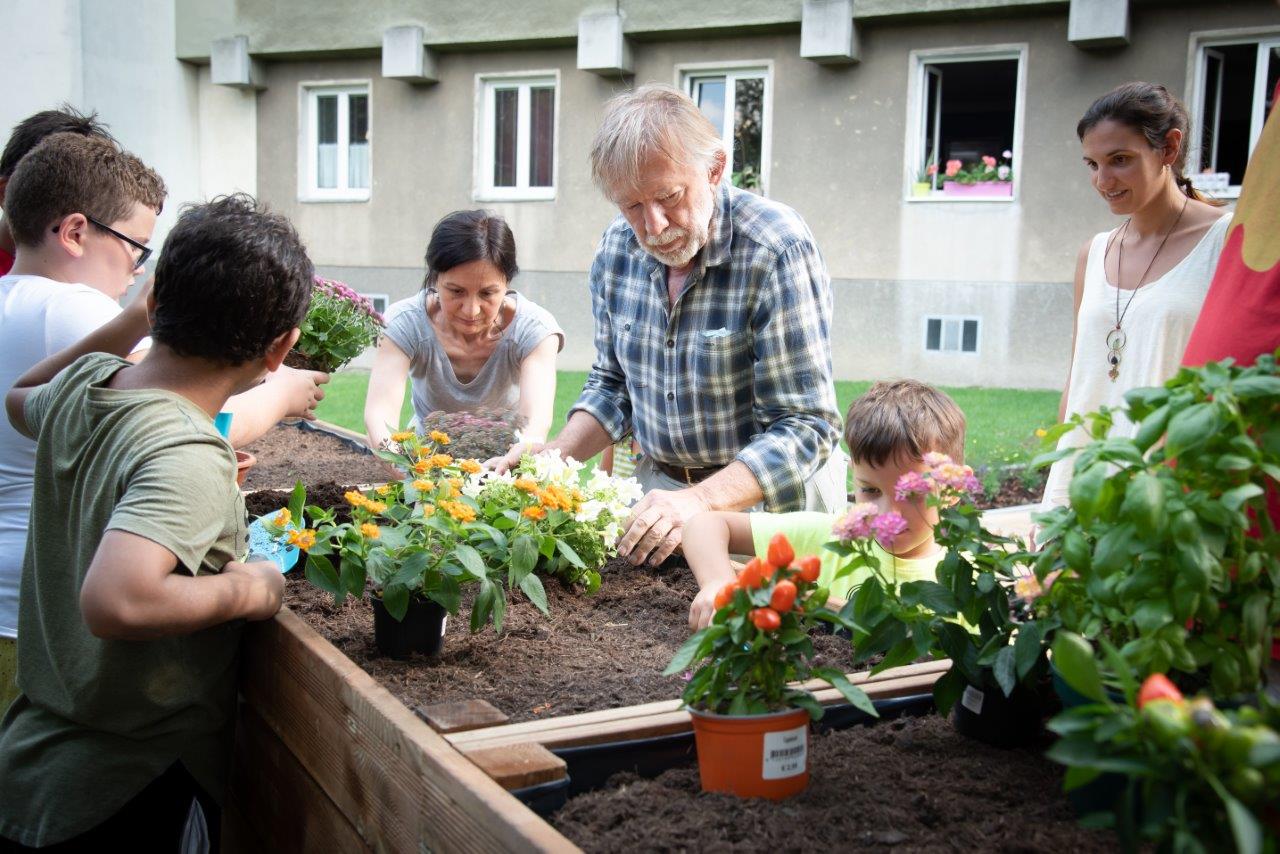 Seniors and children gardening together at the Hofferplatz intergenerational meeting point. Credit: Sarah Bruckner / Häuser zum Leben
Seniors and children gardening together at the Hofferplatz intergenerational meeting point. Credit: Sarah Bruckner / Häuser zum Leben
A number of Viennese senior homes also house kindergartens, a practice that is proving popular worldwide, from Seattle to Singapore. Taking it a step further, some senior homes are also becoming a hub for intergenerational living, solving two problems at once: the struggle of finding affordable housing facing many young people, and the social isolation experienced by seniors. As part of a Young Living program, 50 apartments in the various Häuser zum Leben senior homes are earmarked for students, who contribute 25 hours of volunteer work per month in exchange for affordable rent. At the Humanitas retirement village in the Netherlands six students are living rent-free, offering company and support to their senior neighbors. In the US, a number of colleges partner with senior care facilities to create intergenerational housing solutions, while so-called University-based Retirement Communities (UBRCs) combine senior living with access to university courses and campus facilities for seniors.


Become a sustaining member today!
Join the Reasons to be Cheerful community by supporting our nonprofit publication and giving what you can.
Back in the brewery, the seniors are joined by Lukas and Andy, high school students who are doing a two-week internship at the senior home as part of Compassion Project, a social learning initiative. Rupert is showing them how to label the beer bottles. Keeping the labels straight and smooth is not as easy as it seems, but after almost four years of weekly practice, he’s a pro. From the handle of his wheelchair hangs a black felt bag emblazoned with the motto “the Beauty and the Beer,” a present from his daughter. “This here is our second life chapter,” he says. “And we’re happy to still be needed.”
The post The Grandmas and Grandpas Brewing Beer in Vienna appeared first on Reasons to be Cheerful.
Banking the Most Valuable Currency: Time
David Gill might be the richest man in Sebastopol, California. The semi-retired health care administrator is banking the most valuable currency in the world: time. Gill currently has 480 hours in his savings account at the local time bank, “and I haven’t even registered any of my hours in 2023,” he says.
In brief, a time bank does with time what other banks do with money: It stores and trades it. “Time banking means that for every hour you give to your community, you receive an hour credit,” explains Krista Wyatt, executive director of the DC-based nonprofit TimeBanks.Org, which helps volunteers establish local time banks all over the world. Nobody keeps track of the exact number, but thousands of time banks with several hundred thousand members have been established in at least 37 countries, including China, Malaysia, Japan, Senegal, Argentina, Brazil and in Europe, with over 3.2 million exchanges. There are probably more than 40,000 members in over 500 time banks in the US.
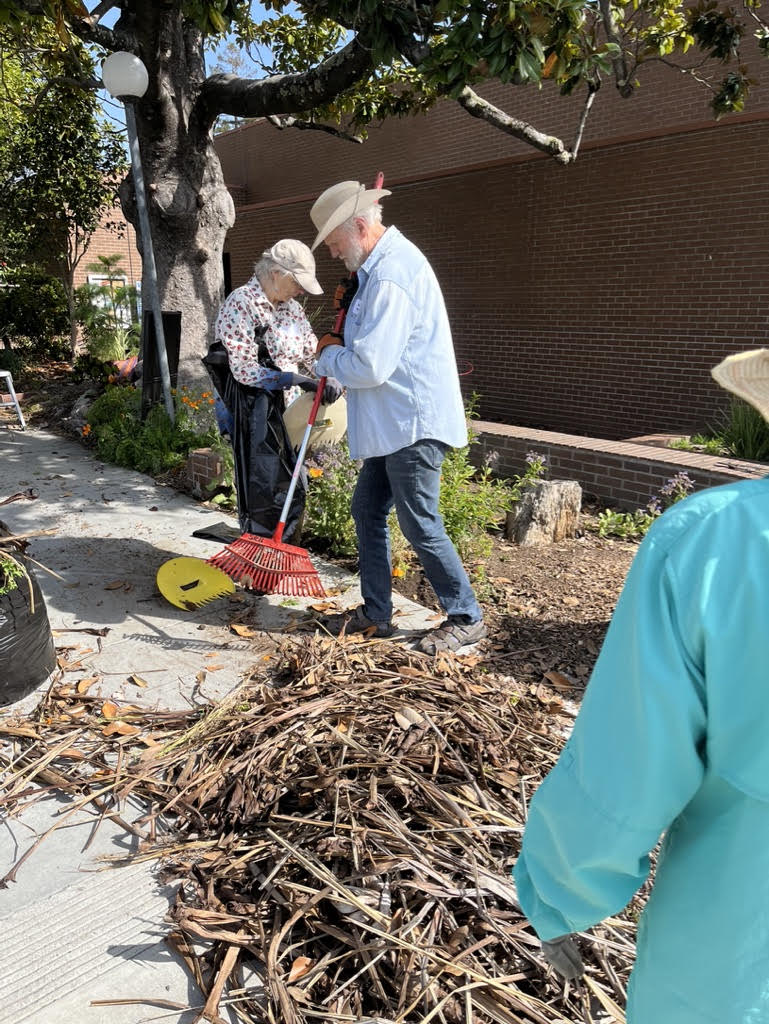 Steve Bursch (with red rake) and fellow time bankers beautify the library grounds for the City of Sebastopol. Credit: Marty Roberts / Sebastopol Area Time Bank
Steve Bursch (with red rake) and fellow time bankers beautify the library grounds for the City of Sebastopol. Credit: Marty Roberts / Sebastopol Area Time Bank
In Sebastopol, 250 residents have time bank accounts where they save and withdraw hours as needed. For instance, Gill, who is also the main local time bank coordinator, likes to offer his expertise with computer programming, editing and financial planning. In return, he asks for help when he needs a ride to the airport or someone to transport heavy furniture. He rattles off the first few of many examples: “Steve, who lives on the next block, drove me and my partner to the Santa Rosa airport. Ken fixed the icemaker in our refrigerator, and Elaine did some electrical work.”
If he had called professional repair and taxi services, the expense would have been significant. However, the interest, so to speak, goes beyond the value of a mere transaction. The time banks are building social capital. “I’ve made wonderful friends I wouldn’t have met otherwise and we now invite each other to our garden parties,” says Gill. “It’s about making community and being a part of the community. You can’t put a price on that stuff.”
David Gill came to the time bank like most of his neighbors. He doesn’t remember where he first heard about it a few years ago, but he immediately thought it was a great idea. He signed up, started using it, and when the founders asked for help, he stepped up. He gets paid in the currency he values most: hours.
Many time banks are volunteer community projects, but the one in Sebastopol is funded by the city and operates under the nonprofit status of the Community Cultural Center. After all, time is money. “Every volunteer hour is valued around $29,” Wyatt calculates. “Now think about the thousands of dollars a city saves when hundreds of citizens serve their community for free.” The Sebastopol time bank has banked more than 8,000 hours since its launch in 2016. Members might reimburse each other for costs — for instance, gas mileage or materials — but the service itself and the membership are always free.
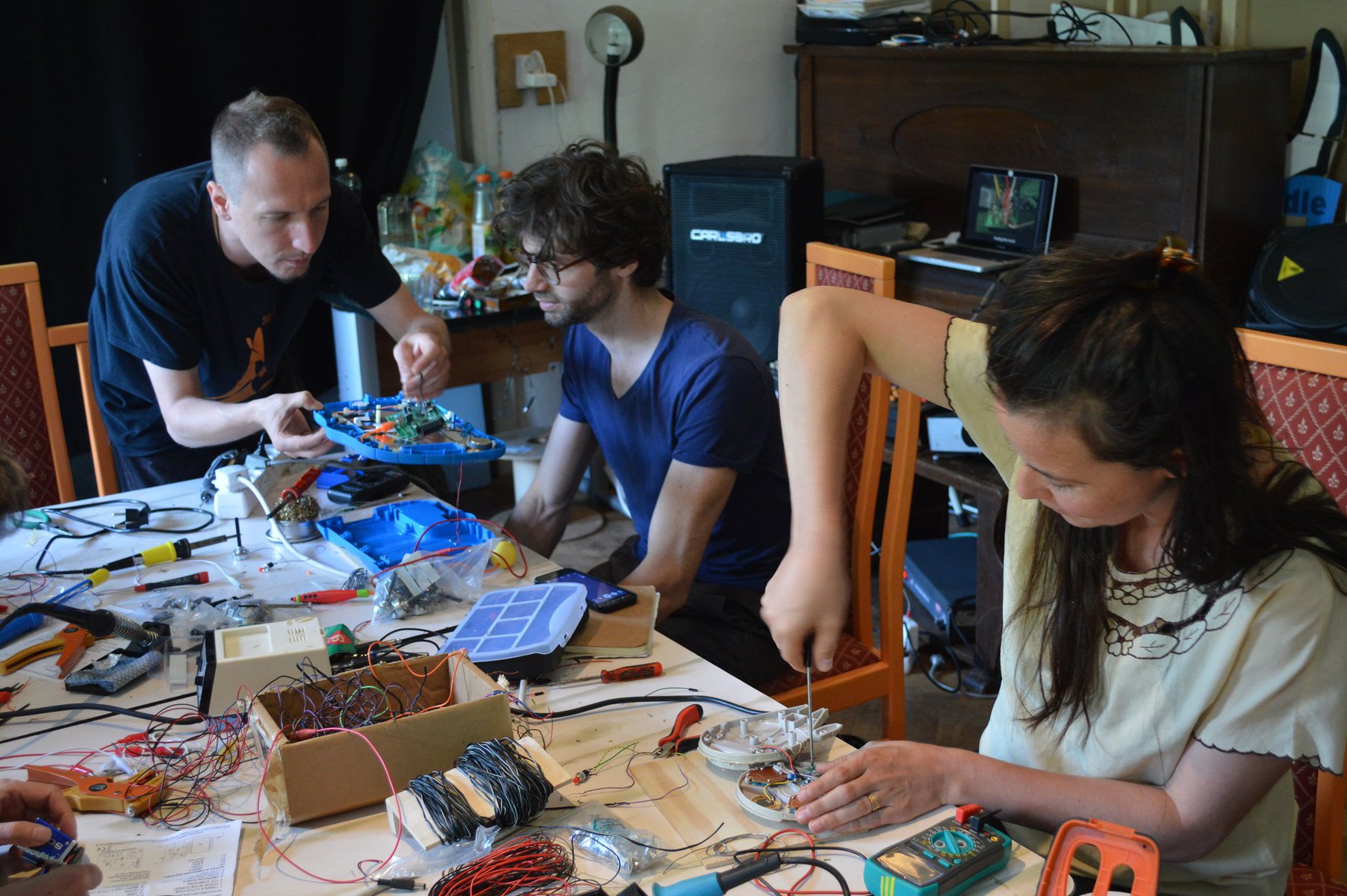 Time bank members in the Netherlands participate in a DIY electronics course. Credit: Timebank.cc
Time bank members in the Netherlands participate in a DIY electronics course. Credit: Timebank.cc
Some cities look to time banks as a model to support an aging population. In St. Gallen, Switzerland, only members over the age of 50 may join the local Stiftung Zeitvorsorge, or “Foundation Time Care,” which was founded in 2011 and has 320 members who have banked more than 80,000 hours. While Sebastopol’s time bank is more geared toward practical services to fill a gap other community services don’t address, members in St. Gallen regularly help seniors run errands, shop for groceries, take them to the doctor or simply keep them company. Here, too, the city guarantees the program, hoping that it will help seniors to stay in their homes and live independently longer because 75 percent of locals said in a poll that they hoped to stay in their homes as long as possible. Even if only five people were enabled to enter care homes a year later, the foundation’s executive director Jürg Weibel recently told the German magazine Der Spiegel, the investment would have already recouped itself. “The reality is that grown-up kids live in other areas,” Weibel said. “Also, many seniors are consciously looking for a new purpose.”
The time banks in both Sebastopol and St. Gallen have more offerings than demand. In a way, they have too much time in the bank, not least because seniors are looking to get help later in life.
Crushed by negative news?
Sign up for the Reasons to be Cheerful newsletter.
[contact-form-7]
“Seniors have a lot to offer,” Gill believes. While he points to his white hair as “pretty representative of the age of our time bank members,” some universities and schools have established time banks specifically for students and teachers at their institutions.
The idea of time as a bankable currency goes back to a Japanese seamstress and activist, Teruko Mizushima, who traded her sewing skills for fresh vegetables during the Pacific War in the early 1940s. In 1973, she started the first “Volunteer Labour Bank” that soon included thousands of members.
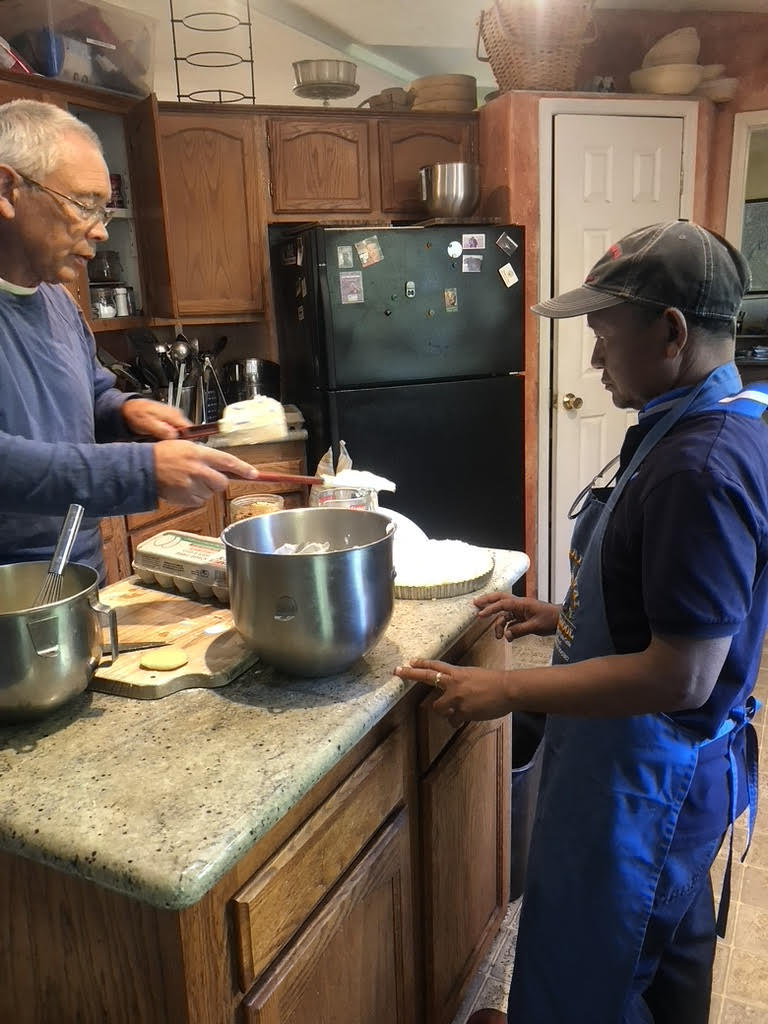 Tong Ginn (left) teaches Jesuda “Wee” Simla how to make croissants. Credit Michael D. Fels / Sebastopol Area Time Bank
Tong Ginn (left) teaches Jesuda “Wee” Simla how to make croissants. Credit Michael D. Fels / Sebastopol Area Time Bank
In the US, the civil rights lawyer Edgar Cahn, who worked as a speechwriter for Robert F. Kennedy and executive assistant to Peace Corps founder Sargent Shriver, rediscovered the idea of time banks as allies to fight poverty in the early 1960s, when money for social programs had dried up. He later coined the term “Time Dollars” and trademarked “Time Bank.” In 1995, he founded the nonprofit Krista Wyatt now works for as a hub of resources, first under the name “Time Dollar Institute.” “When he was bedridden in a hospital after a severe heart attack, he felt ‘useless,’ and saw time banks as a way for everyone to contribute to the community, no matter their age or qualifications,” Wyatt explains.
Cahn formulated five core principles that guide time banks to this day: First, everyone has something to contribute. Second, valuing volunteering as “work.” Third, reciprocity or a “pay-it-forward” ethos. Fourth, community building, and fifth, mutual accountability and respect.
“What captured me is that people are doing things out of their own good heart,” Wyatt says. “Many years ago, a woman got really upset because, as she said to Edgar Cahn, ‘I have nothing to give.’ Edgar Cahn listened and finally responded, ‘You have love to give.’ And the whole room just went silent.”
Every hour of service is valued the same, no matter how much skill and expertise a task takes, whether it’s an hour keeping someone company, helping them file their taxes or repair a roof. Through a simple online platform, every member can offer and request services and then register the hours they served or received. Especially during and since the Covid pandemic, the bank has also been an antidote to the epidemic of loneliness. For instance, the Sebastopol time bank regularly hosts in-person events and meetings.
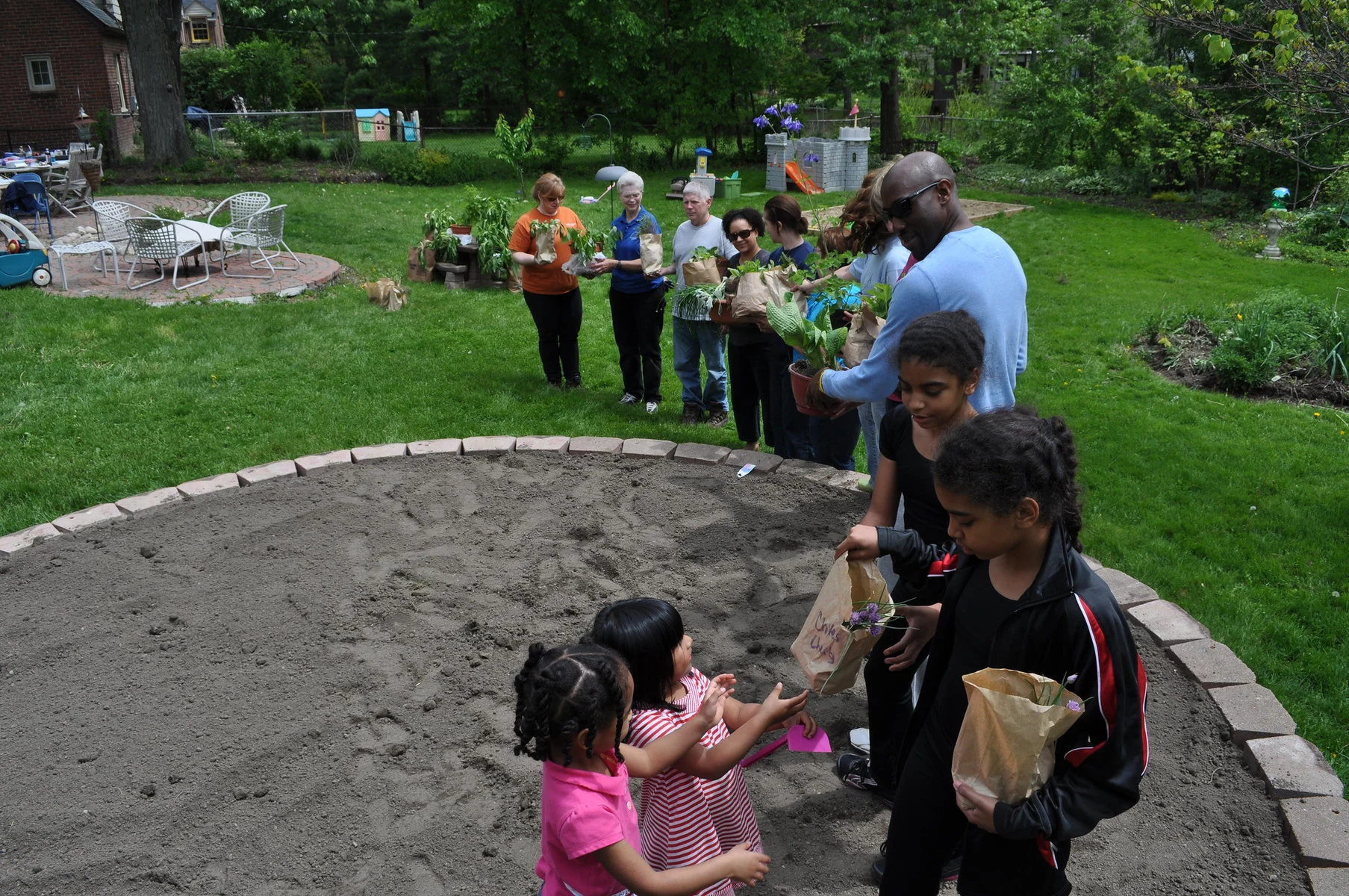 Lathrup Village, Michigan time bank members doing yard work together. Credit: Michigan Municipal League
Lathrup Village, Michigan time bank members doing yard work together. Credit: Michigan Municipal League
“We do events where everybody brings a list of five things they need to get done,” Wyatt gives an example. “You wouldn’t believe how many things get crossed off these lists in a room full of people who are willing to help.”
Wyatt came to TimeBanks after supporting cancer survivors. She’d read Cahn’s 2000 book, No More Throw-Away People, and was looking for a way to give back. “There are people like me who like to work on the computer rather than cleaning my garage,” Wyatt says, “and there are people who’d rather clean a garage than be stuck behind a computer. Everybody can be part of the time bank community. It’s as simple as that.”
In a way, time banks are the 2.0 version of what used to happen organically in small communities: Neighbors and colleagues would help each other out. “Now we simply do it with the help of a computer,” Gill says. “Or you may just pick up the phone and call another member directly rather than post a request online. It helps to get to know the various members.”
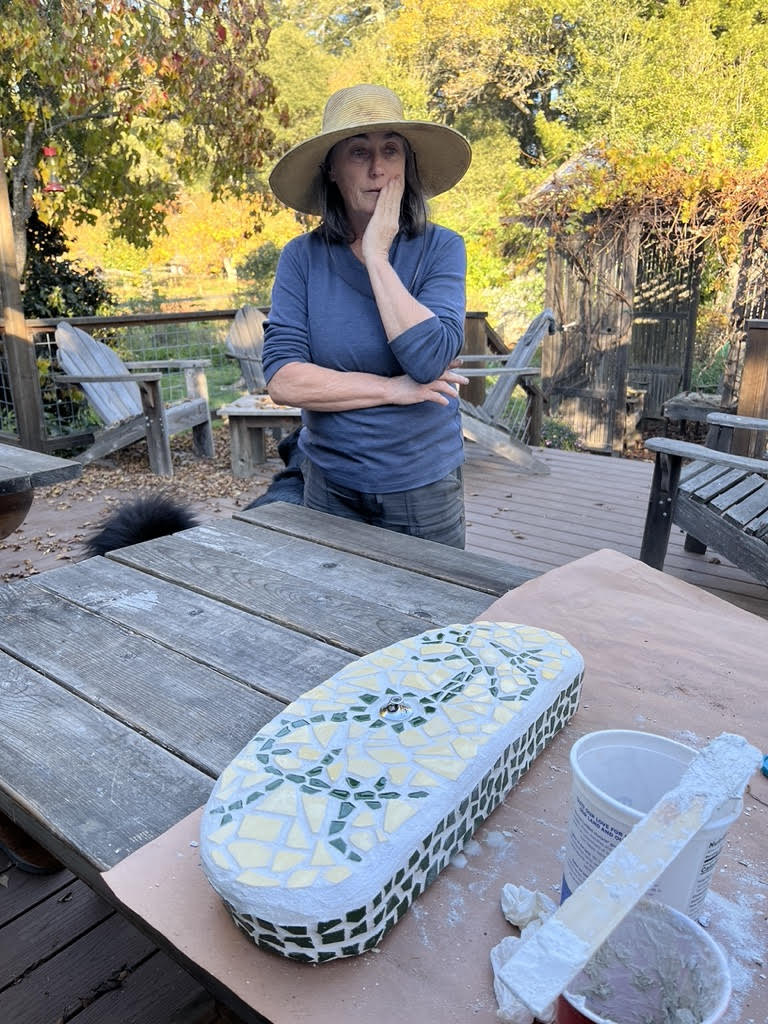 Artist Elizabeth “Liz” Newton with David Gill’s repaired and mosaic toilet tank cover. Credit: David Gill / Sebastopol Area Time Bank
Artist Elizabeth “Liz” Newton with David Gill’s repaired and mosaic toilet tank cover. Credit: David Gill / Sebastopol Area Time Bank
While the core principles are simple, both Wyatt and Gill acknowledge that implementing and managing the time bank well is a complex task. They both spent countless hours trying out different software programs before settling on a program that works well for them.
Wyatt dreams of connecting the various time banks internationally so that someone in, say, San Francisco, could learn French with a time bank member in Paris. Or a tourist traveling in Japan could meet local time bank members there and, after her return, show other tourists around her own town.
Interpreted this way, the time credit functions as an alternative currency. Members can also donate their services to community members in need and the community without banking a credit for themselves.
For instance, in Sebastopol, artist Ellie Kilner completed a giant sculpture at the Sebastopol Senior Arts Center and other art projects with the support of fellow time bank members.


Become a sustaining member today!
Join the Reasons to be Cheerful community by supporting our nonprofit publication and giving what you can.
Gill’s favorite exchange, so far, also has to do with art and with a broken toilet cover. Because the toilet was an ancient model, it was impossible to find a replacement. He posted a request for help on the time bank’s online platform, and a local mosaic artist not only glued the broken pieces together but turned it into a colorful piece of art. “Now it’s a conversation piece!” Gill raves. He says he plans to request more work from this artist, Elizabeth Newton.
He is clearly passionate about his role in facilitating the time bank and everything that time banks can provide: “I don’t think we can ever have too many friends or too much community.”
The post Banking the Most Valuable Currency: Time appeared first on Reasons to be Cheerful.